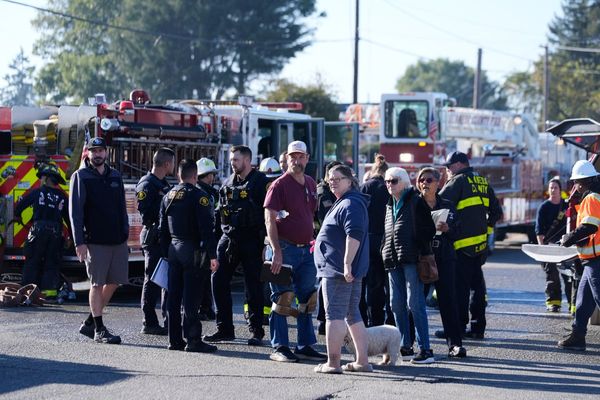Texas Republicans have had a rough go of it over the past few days in the “Byrd bath” process that determines what’s eligible for inclusion in the filibuster-proof reconciliation package.
Late Sunday, the Senate parliamentarian advised that a $10 billion fund to reimburse border states, primarily Texas, for costs associated with security and immigration enforcement as previously drafted was a violation of the so-called Byrd rule and would be subject to a 60-vote point of order if left in the bill as is.
Prior guidance from Senate Parliamentarian Elizabeth MacDonough late Friday left $250 million for the fire-damaged Coast Guard station on South Padre Island “Byrded out” of the bill.
But for sheer symbolism and emotional attachment in the Lone Star State, the deepest cut may be a smaller one: axing $85 million to transfer the space shuttle Discovery to a final resting place near Houston’s Johnson Space Center.
Currently on display at the Smithsonian’s National Air and Space Museum Steven F. Udvar-Hazy Center in Chantilly, Va., getting the Discovery — which, at 39 orbital missions, was the most prolific of the U.S. shuttles — moved to Texas is a top priority for GOP Sens. Ted Cruz and John Cornyn.
They introduced legislation in April to direct the transfer, and Cruz, who is chairman of the Senate Commerce Committee with jurisdiction over NASA, had circulated new language designed for inclusion in his panel’s title of the “big, beautiful” reconciliation bill.
Cornyn — who, according to recent polls, could have a tough time fending off Texas Attorney General Ken Paxton in the GOP Senate primary — was on hand at Johnson Space Center’s visitor center on Friday to tout his efforts to move the shuttle as part of the budget bill.
“We are here because we are going to bring the iconic space shuttle Discovery back home,” Cornyn said in a local news clip that his office posted Friday on the social platform X, hours before the parliamentarian’s advisory became public.
GOP Rep. Randy Weber of Texas was also at the Friday event at Space Center Houston, the official visitor complex for Johnson Space Center, and said he would introduce the House version of the Cornyn-Cruz bill.
New language circulated
Cruz’s initial release of his panel’s reconciliation text included $10 billion for NASA, an add not found in the House-passed version. Included in the Senate package is $1 billion for NASA infrastructure improvements at several “manned spaceflight centers” — incidentally all in GOP-leaning states, a fact not lost on panel Democrats who criticized the plan.
Johnson Space Center would get $300 million of the $1 billion under the original Commerce draft.
The new addition to the text, which was reviewed by the parliamentarian but hasn’t been released publicly, would set aside another $85 million for construction of a facility near Johnson to house an unnamed space vehicle. That vehicle must have “flown into space,” “carried astronauts” and be “selected with the concurrence of a nonprofit entity” designated by NASA, according to the draft language seen by CQ Roll Call.
The unnamed space vehicle would be transferred to Johnson Space Center “to be placed on public exhibition at a nonprofit entity not more than 5 miles from” the facility.
The separate bill from Cornyn and Cruz would specifically direct transfer of the Discovery to a nonprofit within 5 miles of Johnson. Space Center Houston is located within a mile of the facility. It’s operated by a nonprofit called the Manned Space Flight Education Foundation, according to its website.
Local media outlet KHOU 11 reported that Space Center Houston is ready to receive the Discovery if and when it comes.
When asked at Friday’s event how much the project would cost, Cornyn replied, “We’ll let you know.”
Included within the $85 million is $5 million to transport the shuttle, which the KHOU 11 broadcast said may happen by barge.
The report also said Space Center Houston officials expect that the shuttle could be delivered within 18 months, which matches the draft bill language’s “not later than 18 months” time frame.
The contents of the package remained in flux as of Monday, and anything deemed out of compliance with the Byrd rule could potentially be resuscitated in a format that passes muster. But the window is closing as Senate GOP leaders and the White House want to get the bill passed fast, as soon as this week.
And based on MacDonough’s opinions and past precedents, the rule typically weeds out anything in a reconciliation bill that smacks of an earmark for one intended recipient, or that looks like a sweeping policy change being jammed through under the guise of budget tweaks.
A Cornyn spokesperson said they were working with the parliamentarian to address Byrd rule issues raised on both the Texas border reimbursement fund and the shuttle transfer provisions.
Cruz staff didn’t comment on next steps, nor did aides to Democratic Sens. Tim Kaine and Mark Warner, whose Northern Virginia constituents would maintain ready access to the Discovery if the Byrd violation sticks.
Obama-era roots
The Discovery debate was set in motion under a 2010 law reauthorizing NASA, after the Obama administration had announced the end of the space shuttle program.
The law called for retiring the remaining shuttles and making them available for display under a competitive procedure developed by NASA. The Smithsonian, which already had possession of the Enterprise, would determine the test shuttle’s new location.
The law directed NASA to give “priority consideration” to plans “which would provide for the display and maintenance of orbiters at locations with the best potential value to the public.”
Selection criteria included locations that “can advance educational opportunities in science, technology, engineering, and mathematics disciplines, and with an historical relationship with either the launch, flight operations, or processing of the Space Shuttle orbiters or the retrieval of NASA manned space vehicles, or significant contributions to human space flight.”
The process actually began sooner when the Bush administration began looking ahead to the end of the shuttle program, and it kicked into gear after a 2008 NASA reauthorization law was enacted. By the time the 2010 law passed, President Barack Obama’s NASA already was in the planning stages.
In 2011, the Obama administration announced where the retired shuttles would be displayed: The Atlantis went to the Kennedy Space Center Visitor Complex in Florida; the Endeavour went to California Science Center in Los Angeles; the Smithsonian transferred the Enterprise from Udvar-Hazy in Virginia to New York City’s Intrepid Sea, Air and Space Museum; and the Discovery was moved to Udvar-Hazy.
Ever since, some Texas lawmakers have cried foul that Johnson Space Center didn’t get one of the space program’s most important relics because of a political decision by the Obama administration.
“Those of us who’ve been in this battle from the beginning still remember the sting of the Obama administration’s misguided decision to snub Houston, the home of Mission Control and the beating heart of America’s space program, in favor of locations with far less connection to NASA’s legacy,” Weber said in a statement after Friday’s event in Houston.
At the time, then-NASA Administrator Charles F. Bolden Jr., a former astronaut who piloted the Discovery’s mission to deploy the Hubble Space Telescope in 1990, said choosing the locations was a “very difficult decision.” He said it ultimately came down to facilities that would “provide the greatest number of people with the best opportunity to share in the history and accomplishments of NASA’s remarkable space shuttle program.”
A 2011 report by the NASA inspector general’s office acknowledged that the selection process favored sites where the shuttles “would be viewed by the largest number of people rather than the location’s ties to the Shuttle Program or to NASA more generally.” But the report found no evidence of political influence being brought to bear or violation of the law’s selection criteria.
Bolden, who founded a consulting firm after leaving NASA in 2017, wasn’t immediately available for comment on Monday.
The post Houston, we still have a problem: Shuttle move blocked by ‘Byrd rule’ appeared first on Roll Call.







